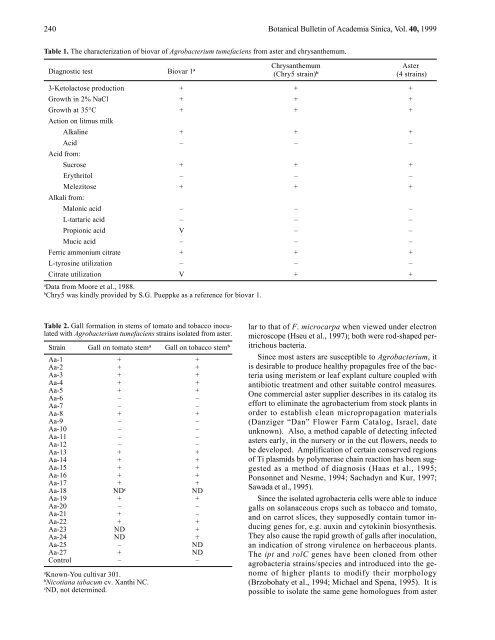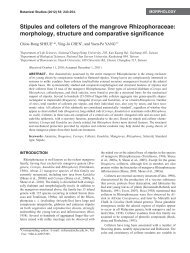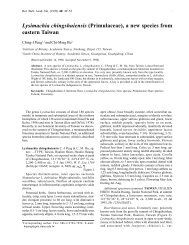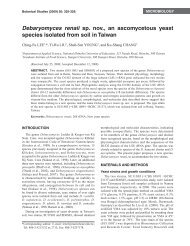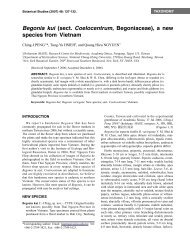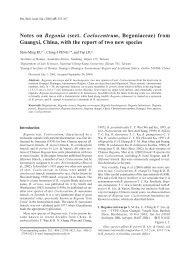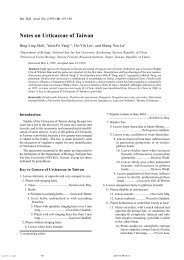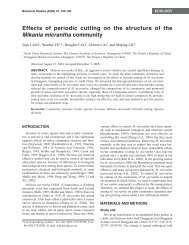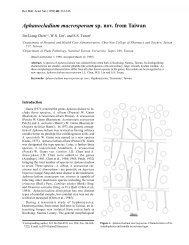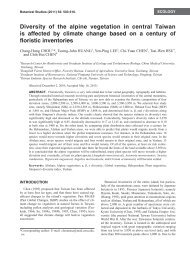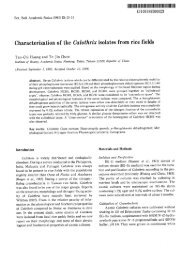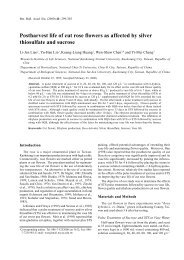Leaf, stem and crown galls on perennial asters ... - Academia Sinica
Leaf, stem and crown galls on perennial asters ... - Academia Sinica
Leaf, stem and crown galls on perennial asters ... - Academia Sinica
You also want an ePaper? Increase the reach of your titles
YUMPU automatically turns print PDFs into web optimized ePapers that Google loves.
240 Botanical Bulletin of <strong>Academia</strong> <strong>Sinica</strong>, Vol. 40, 1999<br />
Table 1. The characterizati<strong>on</strong> of biovar of Agrobacterium tumefaciens from aster <str<strong>on</strong>g>and</str<strong>on</strong>g> chrysanthemum.<br />
Diagnostic test Biovar 1 a Chrysanthemum Aster<br />
(Chry5 strain) b (4 strains)<br />
3-Ketolactose producti<strong>on</strong> + + +<br />
Growth in 2% NaCl + + +<br />
Growth at 35°C + + +<br />
Acti<strong>on</strong> <strong>on</strong> litmus milk<br />
Alkaline + + +<br />
Acid – – –<br />
Acid from:<br />
Sucrose + + +<br />
Erythritol – – –<br />
Melezitose + + +<br />
Alkali from:<br />
Mal<strong>on</strong>ic acid – – –<br />
L-tartaric acid – – –<br />
Propi<strong>on</strong>ic acid V – –<br />
Mucic acid – – –<br />
Ferric amm<strong>on</strong>ium citrate + + +<br />
L-tyrosine utilizati<strong>on</strong> – – –<br />
Citrate utilizati<strong>on</strong> V + +<br />
a<br />
Data from Moore et al., 1988.<br />
b<br />
Chry5 was kindly provided by S.G. Pueppke as a reference for biovar 1.<br />
Table 2. Gall formati<strong>on</strong> in <str<strong>on</strong>g>stem</str<strong>on</strong>g>s of tomato <str<strong>on</strong>g>and</str<strong>on</strong>g> tobacco inoculated<br />
with Agrobacterium tumefaciens strains isolated from aster.<br />
Strain Gall <strong>on</strong> tomato <str<strong>on</strong>g>stem</str<strong>on</strong>g> a Gall <strong>on</strong> tobacco <str<strong>on</strong>g>stem</str<strong>on</strong>g> b<br />
Aa-1 + +<br />
Aa-2 + +<br />
Aa-3 + +<br />
Aa-4 + +<br />
Aa-5 + +<br />
Aa-6 – –<br />
Aa-7 – –<br />
Aa-8 + +<br />
Aa-9 – –<br />
Aa-10– –<br />
Aa-11 – –<br />
Aa-12 – –<br />
Aa-13 + +<br />
Aa-14 + +<br />
Aa-15 + +<br />
Aa-16 + +<br />
Aa-17 + +<br />
Aa-18 ND c ND<br />
Aa-19 + +<br />
Aa-20– –<br />
Aa-21 + –<br />
Aa-22 + +<br />
Aa-23 ND +<br />
Aa-24 ND +<br />
Aa-25 – ND<br />
Aa-27 + ND<br />
C<strong>on</strong>trol – –<br />
a<br />
Known-You cultivar 301.<br />
b<br />
Nicotiana tabacum cv. Xanthi NC.<br />
c<br />
ND, not determined.<br />
lar to that of F. microcarpa when viewed under electr<strong>on</strong><br />
microscope (Hseu et al., 1997); both were rod-shaped peritrichous<br />
bacteria.<br />
Since most <strong>asters</strong> are susceptible to Agrobacterium, it<br />
is desirable to produce healthy propagules free of the bacteria<br />
using meri<str<strong>on</strong>g>stem</str<strong>on</strong>g> or leaf explant culture coupled with<br />
antibiotic treatment <str<strong>on</strong>g>and</str<strong>on</strong>g> other suitable c<strong>on</strong>trol measures.<br />
One commercial aster supplier describes in its catalog its<br />
effort to eliminate the agrobacterium from stock plants in<br />
order to establish clean micropropagati<strong>on</strong> materials<br />
(Danziger “Dan” Flower Farm Catalog, Israel, date<br />
unknown). Also, a method capable of detecting infected<br />
<strong>asters</strong> early, in the nursery or in the cut flowers, needs to<br />
be developed. Amplificati<strong>on</strong> of certain c<strong>on</strong>served regi<strong>on</strong>s<br />
of Ti plasmids by polymerase chain reacti<strong>on</strong> has been suggested<br />
as a method of diagnosis (Haas et al., 1995;<br />
P<strong>on</strong>s<strong>on</strong>net <str<strong>on</strong>g>and</str<strong>on</strong>g> Nesme, 1994; Sachadyn <str<strong>on</strong>g>and</str<strong>on</strong>g> Kur, 1997;<br />
Sawada et al., 1995).<br />
Since the isolated agrobacteria cells were able to induce<br />
<str<strong>on</strong>g>galls</str<strong>on</strong>g> <strong>on</strong> solanaceous crops such as tobacco <str<strong>on</strong>g>and</str<strong>on</strong>g> tomato,<br />
<str<strong>on</strong>g>and</str<strong>on</strong>g> <strong>on</strong> carrot slices, they supposedly c<strong>on</strong>tain tumor inducing<br />
genes for, e.g. auxin <str<strong>on</strong>g>and</str<strong>on</strong>g> cytokinin biosynthesis.<br />
They also cause the rapid growth of <str<strong>on</strong>g>galls</str<strong>on</strong>g> after inoculati<strong>on</strong>,<br />
an indicati<strong>on</strong> of str<strong>on</strong>g virulence <strong>on</strong> herbaceous plants.<br />
The ipt <str<strong>on</strong>g>and</str<strong>on</strong>g> rolC genes have been cl<strong>on</strong>ed from other<br />
agrobacteria strains/species <str<strong>on</strong>g>and</str<strong>on</strong>g> introduced into the genome<br />
of higher plants to modify their morphology<br />
(Brzobohaty et al., 1994; Michael <str<strong>on</strong>g>and</str<strong>on</strong>g> Spena, 1995). It is<br />
possible to isolate the same gene homologues from aster


